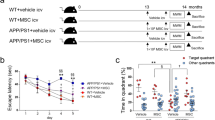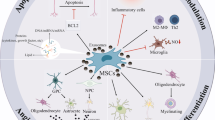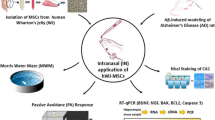Abstract
Neprilysin (NPL), the rate-limiting enzyme for amyloid beta peptide (AβP), appears to play a crucial role in the pathogenesis of Alzheimer’s disease (AD). Since mesenchymal stem cells (MSCs) and/or cerebrolysin (CBL, a combination of neurotrophic factors and active peptide fragments) have neuroprotective effects in various CNS disorders, we examined nanowired delivery of MSCs and CBL on NPL content and brain pathology in AD using a rat model. AD-like symptoms were produced by intraventricular (i.c.v.) administration of AβP (1-40) in the left lateral ventricle (250 ng/10 μl, once daily) for 4 weeks. After 30 days, the rats were examined for NPL and AβP concentrations in the brain and related pathology. Co-administration of TiO2-nanowired MSCs (106 cells) with 2.5 ml/kg CBL (i.v.) once daily for 1 week after 2 weeks of AβP infusion significantly increased the NPL in the hippocampus (400 pg/g) from the untreated control group (120 pg/g; control 420 ± 8 pg/g brain) along with a significant decrease in the AβP deposition (45 pg/g from untreated control 75 pg/g; saline control 40 ± 4 pg/g). Interestingly, these changes were much less evident when the MSCs or CBL treatment was given alone. Neuronal damages, gliosis, and myelin vesiculation were also markedly reduced by the combined treatment of TiO2, MSCs, and CBL in AD. These observations are the first to show that co-administration of TiO2-nanowired CBL and MSCs has superior neuroprotective effects in AD probably due to increasing the brain NPL level effectively, not reported earlier.




Similar content being viewed by others
References
Hersh LB, Rodgers DW (2008) Neprilysin and amyloid beta peptide degradation. Curr Alzheimer Res 5(2):225–231
Mazur-Kolecka B, Frackowiak J (2006) Neprilysin protects human neuronal progenitor cells against impaired development caused by amyloid-beta peptide. Brain Res 1124(1):10–18
Nilsson P, Loganathan K, Sekiguchi M, Winblad B, Iwata N, Saido TC, Tjernberg LO (2015) Loss of neprilysin alters protein expression in the brain of Alzheimer’s disease model mice. Proteomics 15(19):3349–3355. doi:10.1002/pmic.201400211
Hüttenrauch M, Baches S, Gerth J, Bayer TA, Weggen S, Wirths O (2015) Neprilysin deficiency alters the neuropathological and behavioral phenotype in the 5XFAD mouse model of Alzheimer’s disease. J Alzheimers Dis 44(4):1291–1302. doi:10.3233/JAD-142463
Wang DS, Lipton RB, Katz MJ, Davies P, Buschke H, Kuslansky G, Verghese J, Younkin SG et al (2005) Decreased neprilysin immunoreactivity in Alzheimer disease, but not in pathological aging. J Neuropathol Exp Neurol 64(5):378–385
Duyckaerts C, Potier MC, Delatour B (2008) Alzheimer disease models and human neuropathology: similarities and differences. Acta Neuropathol 115(1):5–38
El-Amouri SS, Zhu H, Yu J, Marr R, Verma IM, Kindy MS (2008) Neprilysin: an enzyme candidate to slow the progression of Alzheimer’s disease. Am J Pathol 172(5):1342–1354. doi:10.2353/ajpath.2008.070620
Nalivaeva NN, Fisk LR, Belyaev ND, Turner AJ (2008) Amyloid-degrading enzymes as therapeutic targets in Alzheimer’s disease. Curr Alzheimer Res 5(2):212–224
Tayler H, Fraser T, Miners JS, Kehoe PG, Love S (2010) Oxidative balance in Alzheimer’s disease: relationship to APOE, Braak tangle stage, and the concentrations of soluble and insoluble amyloid-β. J Alzheimers Dis 22(4):1363–1373. doi:10.3233/JAD-2010-101368
Nalivaeva NN, Turner AJ (2016) Role of ageing and oxidative stress in regulation of amyloid-degrading enzymes and development of neurodegeneration. Curr Aging Sci 10(1):32–40
Song JH, Yu JT, Tan L (2015) Brain-derived neurotrophic factor in Alzheimer’s disease: risk, mechanisms, and therapy. Mol Neurobiol 52(3):1477–1493. doi:10.1007/s12035-014-8958-4
Zhang L, Fang Y, Lian Y, Chen Y, Wu T, Zheng Y, Zong H, Sun L et al (2015) Brain-derived neurotrophic factor ameliorates learning deficits in a rat model of Alzheimer’s disease induced by aβ1-42. PLoS One 10(4):e0122415. doi:10.1371/journal.pone.0122415
Diniz BS, Teixeira AL (2011) Brain-derived neurotrophic factor and Alzheimer’s disease: physiopathology and beyond. NeuroMolecular Med 13(4):217–222. doi:10.1007/s12017-011-8154-x
Hachisu M, Konishi K, Hosoi M, Tani M, Tomioka H, Inamoto A, Minami S, Izuno T et al (2015) Beyond the hypothesis of serum anticholinergic activity in Alzheimer’s disease: acetylcholine neuronal activity modulates brain-derived neurotrophic factor production and inflammation in the brain. Neurodegener Dis 15(3):182–187. doi:10.1159/000381531
Iijima-Ando K, Hearn SA, Granger L, Shenton C, Gatt A, Chiang HC, Hakker I, Zhong Y et al (2008) Overexpression of neprilysin reduces alzheimer amyloid-beta42 (Abeta42)-induced neuron loss and intraneuronal Abeta42 deposits but causes a reduction in cAMP-responsive element-binding protein-mediated transcription, age-dependent axon pathology, and premature death in Drosophila. J Biol Chem 283(27):19066–19076. doi:10.1074/jbc.M710509200
Carpentier M, Robitaille Y, DesGroseillers L, Boileau G, Marcinkiewicz M (2002) Declining expression of neprilysin in Alzheimer disease vasculature: possible involvement in cerebral amyloid angiopathy. J Neuropathol Exp Neurol 61(10):849–856
Katsuda T, Tsuchiya R, Kosaka N, Yoshioka Y, Takagaki K, Oki K, Takeshita F, Sakai Y et al (2013) Human adipose tissue-derived mesenchymal stem cells secrete functional neprilysin-bound exosomes. Sci Rep 3:1197. doi:10.1038/srep01197
Kim JY, Kim DH, Kim JH, Lee D, Jeon HB, Kwon SJ, Kim SM, Yoo YJ et al (2012) Soluble intracellular adhesion molecule-1 secreted by human umbilical cord blood-derived mesenchymal stem cell reduces amyloid-β plaques. Cell Death Differ 19(4):680–691. doi:10.1038/cdd.2011.140
Yang H, Xie Z, Wei L, Yang H, Yang S, Zhu Z, Wang P, Zhao C et al (2013) Human umbilical cord mesenchymal stem cell-derived neuron-like cells rescue memory deficits and reduce amyloid-beta deposition in an AβPP/PS1 transgenic mouse model. Stem Cell Res Ther 4(4):76. doi:10.1186/scrt227
Habisch HJ, Schmid B, von Arnim CA, Ludolph AC, Brenner R, Storch A (2010) Efficient processing of Alzheimer’s disease amyloid-beta peptides by neuroectodermally converted mesenchymal stem cells. Stem Cells Dev 19(5):629–633. doi:10.1089/scd.2009.0045
Sharma HS, Castellani RJ, Smith MA, Sharma A (2012) The blood-brain barrier in Alzheimer’s disease: novel therapeutic targets and nanodrug delivery. Int Rev Neurobiol 102:47–90. doi:10.1016/B978-0-12-386986-9.00003-X
Sharma HS, Muresanu DF, Sharma A (2016) Alzheimer’s disease: cerebrolysin and nanotechnology as a therapeutic strategy. Neurodegener Dis Manag 6(6):453–456
Guide for the Care and Use of Laboratory Animals (2011) 8th edition, National Institute of Health, The National Academies Press, Washington DC, www.nap.edu
Vorobyov V, Kaptsov V, Gordon R, Makarova E, Podolski I, Sengpiel F (2015) Neuroprotective effects of hydrated fullerene C60: cortical and hippocampal EEG interplay in an amyloid-infused rat model of Alzheimer’s disease. J Alzheimers Dis 45(1):217–233. doi:10.3233/JAD-142469
Anand A, Banik A, Thakur K, Masters CL (2012) The animal models of dementia and Alzheimer’s disease for pre-clinical testing and clinical translation. Curr Alzheimer Res 9(9):1010–1029
Alzoubi KH, Alhaider IA, Tran TT, Mosely A, Alkadhi KK (2011) Impaired neural transmission and synaptic plasticity in superior cervical ganglia from β-amyloid rat model of Alzheimer’s disease. Curr Alzheimer Res 8(4):377–384
Schmidt SD, Mazzella MJ, Nixon RA, Mathews PM (2012) Aβ measurement by enzyme-linked immunosorbent assay. Methods Mol Biol 849:507–527. doi:10.1007/978-1-61779-551-0_34
Lachno DR, Evert BA, Maloney K, Willis BA, Talbot JA, Vandijck M, Dean RA (2015) Validation and clinical utility of ELISA methods for quantification of amyloid-β of peptides in cerebrospinal fluid specimens from Alzheimer’s disease studies. J Alzheimers Dis 45(2):527–542
Schmidt SD, Nixon RA, Mathews PM (2005) ELISA method for measurement of amyloid-beta levels. Methods Mol Biol 299:279–297
Miners JS, Verbeek MM, Rikkert MO, Kehoe PG, Love S (2008) Immunocapture-based fluorometric assay for the measurement of neprilysin-specific enzyme activity in brain tissue homogenates and cerebrospinal fluid. J Neurosci Methods 167(2):229–236
Krämer HH, He L, Lu B, Birklein F, Sommer C (2009) Increased pain and neurogenic inflammation in mice deficient of neutral endopeptidase. Neurobiol Dis 35(2):177–183. doi:10.1016/j.nbd.2008.11.002
Huang H, Bihaqi SW, Cui L, Zawia NH (2011) In vitro Pb exposure disturbs the balance between Aβ production and elimination: the role of AβPP and neprilysin. Neurotoxicology 32(3):300–306. doi:10.1016/j.neuro.2011.02.001
Sharma HS, Feng L, Lafuente JV, Muresanu DF, Tian ZR, Patnaik R, Sharma A (2015) TiO2-Nanowired delivery of mesenchymal stem cells thwarts diabetes- induced exacerbation of brain pathology in heat stroke: an experimental study in the rat using morphological and biochemical approaches. CNS Neurol Disord Drug Targets 14(3):386–399
Tian ZR, Sharma A, Nozari A, Subramaniam R, Lundstedt T, Sharma HS (2012) Nanowired drug delivery to enhance neuroprotection in spinal cord injury. CNS Neurol Disord Drug Targets 11(1):86–95
Sharma A, Menon P, Muresanu DF, Ozkizilcik A, Tian ZR, Lafuente JV, Sharma HS (2016) Nanowired drug delivery across the blood-brain barrier in central nervous system injury and repair. CNS Neurol Disord Drug Targets 15(9):1092–1117
Menon PK, Muresanu DF, Sharma A, Mössler H, Sharma HS (2012) Cerebrolysin, a mixture of neurotrophic factors induces marked neuroprotection in spinal cord injury following intoxication of engineered nanoparticles from metals. CNS Neurol Disord Drug Targets 11(1):40–49
Sharma HS, Olsson Y, Dey PK (1990) Changes in blood-brain barrier and cerebral blood flow following elevation of circulating serotonin level in anesthetized rats. Brain Res 517(1–2):215–223
Sharma HS, Dey PK (1986) Influence of long-term immobilization stress on regional blood-brain barrier permeability, cerebral blood flow and 5-HT level in conscious normotensive young rats. J Neurol Sci 72(1):61–76
Olsson Y, Sharma HS, Pettersson CA (1990) Effects of p-chlorophenylalanine on microvascular permeability changes in spinal cord trauma. An experimental study in the rat using 131I-sodium and lanthanum tracers. Acta Neuropathol 79(6):595–603
Sharma HS, Cervós-Navarro J (1990) Brain oedema and cellular changes induced by acute heat stress in young rats. Acta Neurochir Suppl (Wien) 51:383–386
Elliott KA, Jasper H (1949) Measurement of experimentally induced brain swelling and shrinkage. Am J Phys 157(1):122–129
Sharma HS, Olsson Y, Persson S, Nyberg F (1995) Trauma-induced opening of the blood-spinal cord barrier is reduced by indomethacin, an inhibitor of prostaglandin biosynthesis. Experimental observations in the rat using [131I]-sodium, Evans blue and lanthanum as tracers. Restor Neurol Neurosci 7(4):207–215. doi:10.3233/RNN-1994-7403
Sharma HS, Miclescu A, Wiklund L (2011) Cardiac arrest-induced regional blood-brain barrier breakdown, edema formation and brain pathology: a light and electron microscopic study on a new model for neurodegeneration and neuroprotection in porcine brain. J Neural Transm (Vienna) 118(1):87–114. doi:10.1007/s00702-010-0486-4
Sharma HS, Kiyatkin EA (2009) Rapid morphological brain abnormalities during acute methamphetamine intoxication in the rat: An experimental study using light and electron microscopy. J Chem Neuroanat 37(1):18–32. doi:10.1016/j.jchemneu.2008.08.002
Kiyatkin EA, Sharma HS (2009) Permeability of the blood-brain barrier depends on brain temperature. Neuroscience 161(3):926–939. doi:10.1016/j.neuroscience.2009.04.004
Sharma HS, Olsson Y, Cervós-Navarro J (1993) Early perifocal cell changes and edema in traumatic injury of the spinal cord are reduced by indomethacin, an inhibitor of prostaglandin synthesis. Experimental study in the rat. Acta Neuropathol 85(2):145–153
Sharma HS, Zimmer C, Westman J, Cervós-Navarro J (1992) Acute systemic heat stress increases glial fibrillary acidic protein immunoreactivity in brain: experimental observations in conscious normotensive young rats. Neuroscience 48(4):889–901
Finder VH, Vodopivec I, Nitsch RM, Glockshuber R (2010) The recombinant amyloid-beta peptide Abeta1-42 aggregates faster and is more neurotoxic than synthetic Abeta1-42. J Mol Biol 396(1):9–18. doi:10.1016/j.jmb.2009.12.016
Van Dam D, De Deyn PP (2011) Animal models in the drug discovery pipeline for Alzheimer’s disease. Br J Pharmacol 164(4):1285–1300. doi:10.1111/j.1476-5381.2011.01299.x
Laurijssens B, Aujard F, Rahman A (2013) Animal models of Alzheimer’s disease and drug development. Drug Discov Today Technol 10(3):e319–e327. doi:10.1016/j.ddtec.2012.04.001
Yamada K, Nabeshima T (2000) Animal models of Alzheimer’s disease and evaluation of anti-dementia drugs. Pharmacol Ther 88(2):93–113
Dorr A, Sahota B, Chinta LV, Brown ME, Lai AY, Ma K, Hawkes CA, McLaurin J et al (2012) Amyloid-β-dependent compromise of microvascular structure and function in a model of Alzheimer’s disease. Brain 135(Pt 10):3039–3050. doi:10.1093/brain/aws243
Ni R, Gillberg PG, Bergfors A, Marutle A, Nordberg A (2013) Amyloid tracers detect multiple binding sites in Alzheimer’s disease brain tissue. Brain 136(Pt 7):2217–2227. doi:10.1093/brain/awt142
Blennow K, Mattsson N, Schöll M, Hansson O, Zetterberg H (2015) Amyloid biomarkers in Alzheimer’s disease. Trends Pharmacol Sci 36(5):297–309. doi:10.1016/j.tips.2015.03.002
Izco M, Martínez P, Corrales A, Fandos N, García S, Insua D, Montañes M, Pérez-Grijalba V et al (2014) Changes in the brain and plasma Aβ peptide levels with age and its relationship with cognitive impairment in the APPswe/PS1dE9 mouse model of Alzheimer’s disease. Neuroscience 263:269–279. doi:10.1016/j.neuroscience.2014.01.003
Blennow K, Hampel H, Zetterberg H (2014) Biomarkers in amyloid-β immunotherapy trials in Alzheimer’s disease. Neuropsychopharmacology 39(1):189–201. doi:10.1038/npp.2013.154
Marr RA, Hafez DM (2014) Amyloid-beta and Alzheimer’s disease: the role of neprilysin-2 in amyloid-beta clearance. Front Aging Neurosci 6:187. doi:10.3389/fnagi.2014.00187
Mawuenyega KG, Sigurdson W, Ovod V, Munsell L, Kasten T, Morris JC, Yarasheski KE, Bateman RJ (2010) Decreased clearance of CNS beta-amyloid in Alzheimer’s disease. Science 330(6012):1774. doi:10.1126/science.1197623
Lucey BP, Mawuenyega KG, Patterson BW, Elbert DL, Ovod V, Kasten T, Morris JC, Bateman RJ (2016) Associations between β-amyloid kinetics and the β-amyloid diurnal pattern in the central nervous system. JAMA Neurol. doi:10.1001/jamaneurol.2016.4202
Roberts KF, Elbert DL, Kasten TP, Patterson BW, Sigurdson WC, Connors RE, Ovod V, Munsell LY et al (2014) Amyloid-β efflux from the central nervous system into the plasma. Ann Neurol 76(6):837–844. doi:10.1002/ana.24270
Bateman RJ, Munsell LY, Morris JC, Swarm R, Yarasheski KE, Holtzman DM (2006) Human amyloid-beta synthesis and clearance rates as measured in cerebrospinal fluid in vivo. Nat Med 12(7):856–861
Jha NK, Jha SK, Kumar D, Kejriwal N, Sharma R, Ambasta RK, Kumar P (2015) Impact of insulin degrading enzyme and neprilysin in Alzheimer’s disease biology: characterization of putative cognates for therapeutic applications. J Alzheimers Dis 48(4):891–917. doi:10.3233/JAD-150379
Meilandt WJ, Cisse M, Ho K, Wu T, Esposito LA, Scearce-Levie K, Cheng IH, Yu GQ et al (2009) Neprilysin overexpression inhibits plaque formation but fails to reduce pathogenic Abeta oligomers and associated cognitive deficits in human amyloid precursor protein transgenic mice. J Neurosci 29(7):1977–1986. doi:10.1523/JNEUROSCI.2984-08.2009
Li Y, Wang J, Zhang S, Liu Z (2015) Neprilysin gene transfer: a promising therapeutic approach for Alzheimer’s disease. J Neurosci Res 93(9):1325–1329. doi:10.1002/jnr.23564
Park MH, Lee JK, Choi S, Ahn J, Jin HK, Park JS, Bae JS (2013) Recombinant soluble neprilysin reduces amyloid-beta accumulation and improves memory impairment in Alzheimer’s disease mice. Brain Res 1529:113–124. doi:10.1016/j.brainres.2013.05.045
Liang K, Yang L, Yin C, Xiao Z, Zhang J, Liu Y, Huang J (2010) Estrogen stimulates degradation of beta-amyloid peptide by up-regulating neprilysin. J Biol Chem 285(2):935–942. doi:10.1074/jbc.M109.051664
Yang L, Hao J, Zhang J, Xia W, Dong X, Hu X, Kong F, Cui X (2009) Ginsenoside Rg3 promotes beta-amyloid peptide degradation by enhancing gene expression of neprilysin. J Pharm Pharmacol 61(3):375–380. doi:10.1211/jpp/61.03.0013
Ubhi K, Rockenstein E, Vazquez-Roque R, Mante M, Inglis C, Patrick C, Adame A, Fahnestock M et al (2013) Cerebrolysin modulates pronerve growth factor/nerve growth factor ratio and ameliorates the cholinergic deficit in a transgenic model of Alzheimer’s disease. J Neurosci Res 91(2):167–177. doi:10.1002/jnr.23142
Yao XQ, Jiao SS, Saadipour K, Zeng F, Wang QH, Zhu C, Shen LL, Zeng GH et al (2015) p75NTR ectodomain is a physiological neuroprotective molecule against amyloid-beta toxicity in the brain of Alzheimer’s disease. Mol Psychiatry 20(11):1301–1310. doi:10.1038/mp.2015.49
Cattaneo A, Calissano P (2012) Nerve growth factor and Alzheimer’s disease: new facts for an old hypothesis. Mol Neurobiol 46(3):588–604. doi:10.1007/s12035-012-8310-9
Paradisi M, Alviano F, Pirondi S, Lanzoni G, Fernandez M, Lizzo G, Giardino L, Giuliani A et al (2014) Human mesenchymal stem cells produce bioactive neurotrophic factors: source, individual variability and differentiation issues. Int J Immunopathol Pharmacol 27(3):391–402
Lee JH, Lee JY, Yang SH, Lee EJ, Kim HW (2014) Carbon nanotube-collagen three-dimensional culture of mesenchymal stem cells promotes expression of neural phenotypes and secretion of neurotrophic factors. Acta Biomater 10(10):4425–4436. doi:10.1016/j.actbio.2014.06.023
Hofer HR, Tuan RS (2016) Secreted trophic factors of mesenchymal stem cells support neurovascular and musculoskeletal therapies. Stem Cell Res Ther 7(1):131. doi:10.1186/s13287-016-0394-0
Caplan AI, Dennis J (2006) Mesenchymal stem cells as trophic mediators. J Cell Biochem 98(5):1076–1084
Zhang C, Zheng X, Wan X, Shao X, Liu Q, Zhang Z, Zhang Q (2014) The potential use of H102 peptide-loaded dual-functional nanoparticles in the treatment of Alzheimer’s disease. J Control Release 192:317–324. doi:10.1016/j.jconrel.2014.07.050
Kwon HJ, Cha MY, Kim D, Kim DK, Soh M, Shin K, Hyeon T, Mook-Jung I (2016) Mitochondria-targeting ceria nanoparticles as antioxidants for Alzheimer’s disease. ACS Nano 10(2):2860–2870. doi:10.1021/acsnano.5b08045
Liu Y, An S, Li J, Kuang Y, He X, Guo Y, Ma H, Zhang Y et al (2016) Brain-targeted co-delivery of therapeutic gene and peptide by multifunctional nanoparticles in Alzheimer’s disease mice. Biomaterials 80:33–45. doi:10.1016/j.biomaterials.2015.11.060
Acknowledgements
The study was supported by grants from the Air Force Office of Scientific Research (EOARD, London, UK), and Air Force Material Command, USAF, under grant number FA8655-05-1-3065; the Alzheimer’s Association (IIRG-09-132087), the National Institutes of Health (R01 AG028679) and the Dr. Robert M. Kohrman Memorial Fund (MAS, RJC); Swedish Medical Research Council (Nr 2710-HSS), Göran Gustafsson Foundation, Stockholm, Sweden (HSS); Astra Zeneca, Mölndal, Sweden (HSS/AS); The University Grants Commission, New Delhi, India (HSS/AS), Ministry of Science & Technology, Govt. of India (HSS/AS), Indian Medical Research Council, New Delhi, India (HSS/AS), and India-EU Co-operation Program (RP/AS/HSS) and IT 794/13 (JVL); Government of Basque Country and UFI 11/32 (JVL) University of Basque Country, Spain; and Society for Neuroprotection and Neuroplasticity (SSNN), Romania. Technical and human support provided by Dr. Ricardo Andrade from SGIker (UPV/EHU) is gratefully acknowledged. We thank Suraj Sharma, Uppsala, Sweden, for computer and graphic support. The US Government is authorized to reproduce and distribute reprints for government purpose notwithstanding any copyright notation thereon. The views and conclusions contained herein are those of the authors and should not be interpreted as necessarily representing the official policies or endorsements, either expressed or implied, of the Air Force Office of Scientific Research or the US Government.
Author information
Authors and Affiliations
Corresponding author
Ethics declarations
All experiments were carried out according to the National Institute of Health (NIH) Guide for the Care and Use of Laboratory Animals and approved by the Local Institutional Ethics Committee.
Rights and permissions
About this article
Cite this article
Sharma, H.S., Muresanu, D.F., Lafuente, J.V. et al. Co-Administration of TiO2 Nanowired Mesenchymal Stem Cells with Cerebrolysin Potentiates Neprilysin Level and Reduces Brain Pathology in Alzheimer’s Disease. Mol Neurobiol 55, 300–311 (2018). https://doi.org/10.1007/s12035-017-0742-9
Published:
Issue Date:
DOI: https://doi.org/10.1007/s12035-017-0742-9




